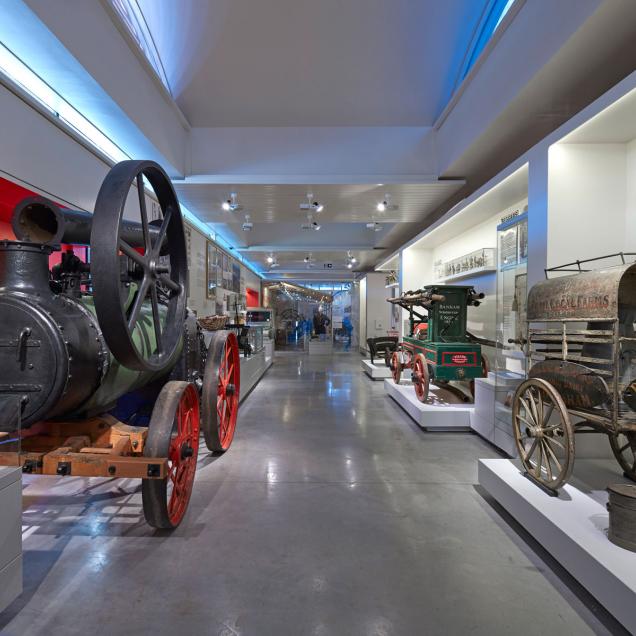

The initially sceptical PETER FROST is won over by a museum in Reading that chose to show the story of the countryside life as one that was far from the idyll pictured on biscuit tins.
Friday, 28th October 2016
Views on the English countryside can be complicated. Here is a letter from one Victorian country gent to his friend in London: “On Saturday, I went out fox-hunting — seven hours in the saddle […] It’s the greatest physical pleasure I know. One fox killed and I was in at the death.” The writer? Fredrick Engels. His London pal? Karl Marx.
Another Victorian was Alfred Palmer, one half of the famous Reading biscuit making partnership Huntley and Palmer. The company often sold their biscuits in beautiful tins covered with cosy idolised views of the English countryside. They pictured thatched cottages with roses growing round the door; apple-cheeked yeoman farmers showed off their bulldogs and dutiful farmers’ wives, who when they weren’t churning butter were plaiting a quick corn dolly. It was never a very accurate picture but it entered the English culture and helped shape our national psyche.
Regular readers of this column will know I have a different view. Mine is the English countryside of Tolpuddle, Captain Swing, Wat Tyler, the Kinder Trespass, the Burston strike school, Joseph Arch and his Agricultural Labourers Union, the Braunston canal boat strike and a score of other chapters of rural history where working people have fought for their rights in the countryside.
My viewpoint focuses on the battle against cruel sports and for fair agricultural wages, against lawbreaking gamekeepers and the outrage of tied cottages, badger culls and profit hungry agribusiness, fair milk prices and supermarket bullying, national parks as well as the common agricultural policy or mega-dairies.
The biscuit-maker Palmer — having made his fortune — gave his mansion on the edge of Reading to the town’s university in 1911. Today the house — much extended — has become home to the Museum of English Rural Life, which has just opened again after a two year, £3.3 million redevelopment.
I went along to see how the money had been spent, and to be honest, with some reservations. Too many of the rural life museums I have visited are far closer to Palmer’s biscuit tin idyllic images than to real life. It seems I needn’t have worried. The museum may have plenty of farmer’s smocks, farm carts and curious agricultural artefacts but it also has a good supply of red radical rural blood coursing through its veins. Its focus is always on real people and real issues.
One of the first exhibits to catch my eye at the main entrance was socialist artist Walter Crane’s 1913 embroidered banner made for the National Agricultural Labourers & Rural Workers Union. It was that union’s very first banner. Decorated with sun, plough, ears of corn, flowers and fruit, it is inscribed with the slogan: “We sow the seed that feeds the world.” Alongside on display are plaster casts of Joseph Arch’s hands — the hands of the man who founded that first agricultural trade union. Arch was a skilled hedge-layer from Warwickshire.
In 1872 Karl Marx described what he saw in the British countryside as the “great awakening” of British agricultural workers. It was in that year that Arch founded the National Agricultural Labourers’ Union under the chestnut tree on the village green in Wellesbourne, Warwickshire. His supporters organised a meeting to hear him speak. On a wet and stormy night they hoped for crowd of perhaps 30. In fact, over 2,000 agricultural workers arrived to hear Arch speak and to join his union.
Many other issues and disputes are aired among the thousands of exhibits packed into the new remodelled museum. I was surprised how many of my countryside issue boxes the museum managed to tick. As well as real exhibits, archive film and evocative photographs bring alive the many stories. These include the Women’s Land Army, WWII child evacuees, hop pickers from London’s slums escaping to the fresh air and good food of Kent. These and many other tales are told with both emotion and real understanding.
No museum today is complete without a good gimmick and this one has a beauty. It is a full-size animated plastic cow. Children and embarrassment-resistant adults can press a lever at the front end for a satisfying moo, extract synthetic milk from the synthetic udders underneath or, best of all, approach the rear end and press the lever to get a realistically malodorous fart to remind you of the massive contribution that cattle make to greenhouse gases and ozone layer depletion.
I started this column with Huntley and Palmer biscuit tins and I’ll end with them too. Nearly 40 years ago the biscuit company, by then absorbed into mega-company Associated Biscuits, decided to re-introduce its rural idyll biscuit tin designs. It commissioned an artist to produce an intricate scene of a happy garden party on the lawns of a thatched country cottage. It was very much in the Edwardian Kate Greenaway nursery rhyme rural style. The artist was either very bored or very naughty. One version of the story has him as a disgruntled employee working out his notice. Whatever, hidden in the elaborate design he managed to incorporate a naked copulating couple and a pair of dogs engaged in the same activity. The tiny jam jar on the table appears to be labelled “shit.”
Thousands of decorative tins were sold before this rudery was spotted. Today these very collectable items sell for hundreds of pounds at auction. Sadly, they didn’t actually have one on display at the re-opened museum, but there wasn’t much else missing from their comprehensive telling of the rich story of our English countryside.
To find out more about the Museum of English Rural Life visit www.reading.ac.uk/theMERL. Free admission.